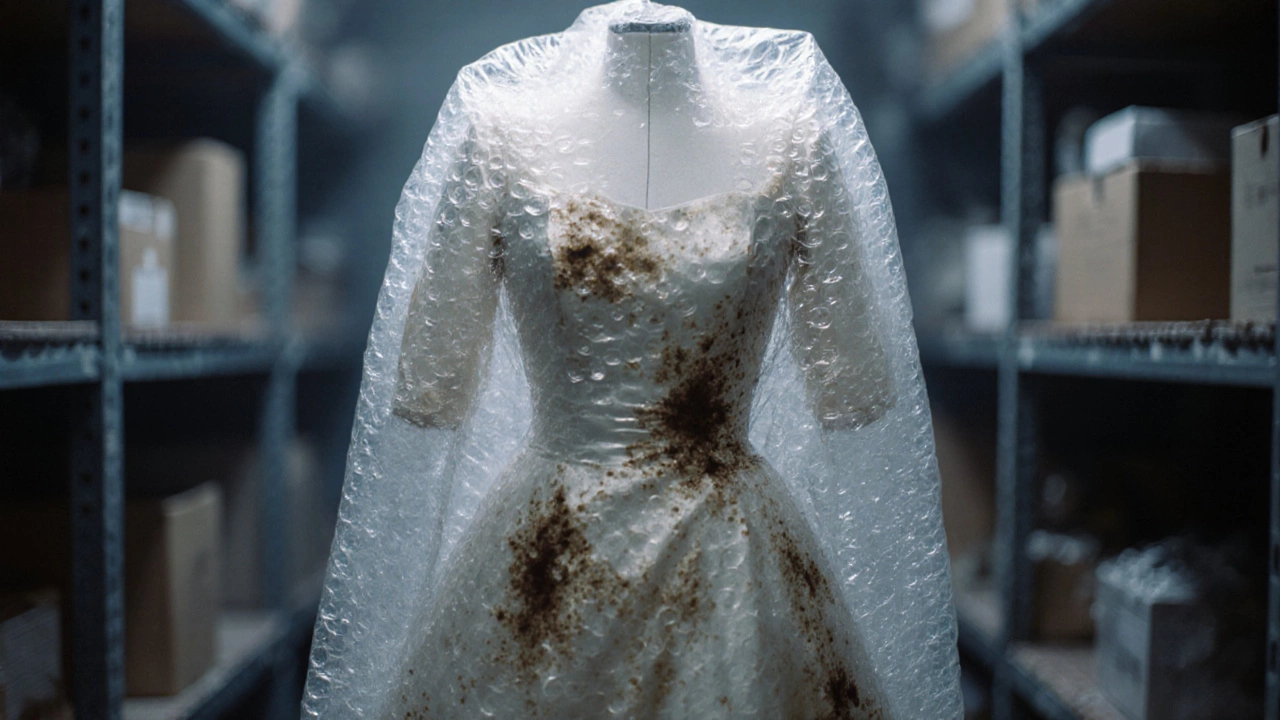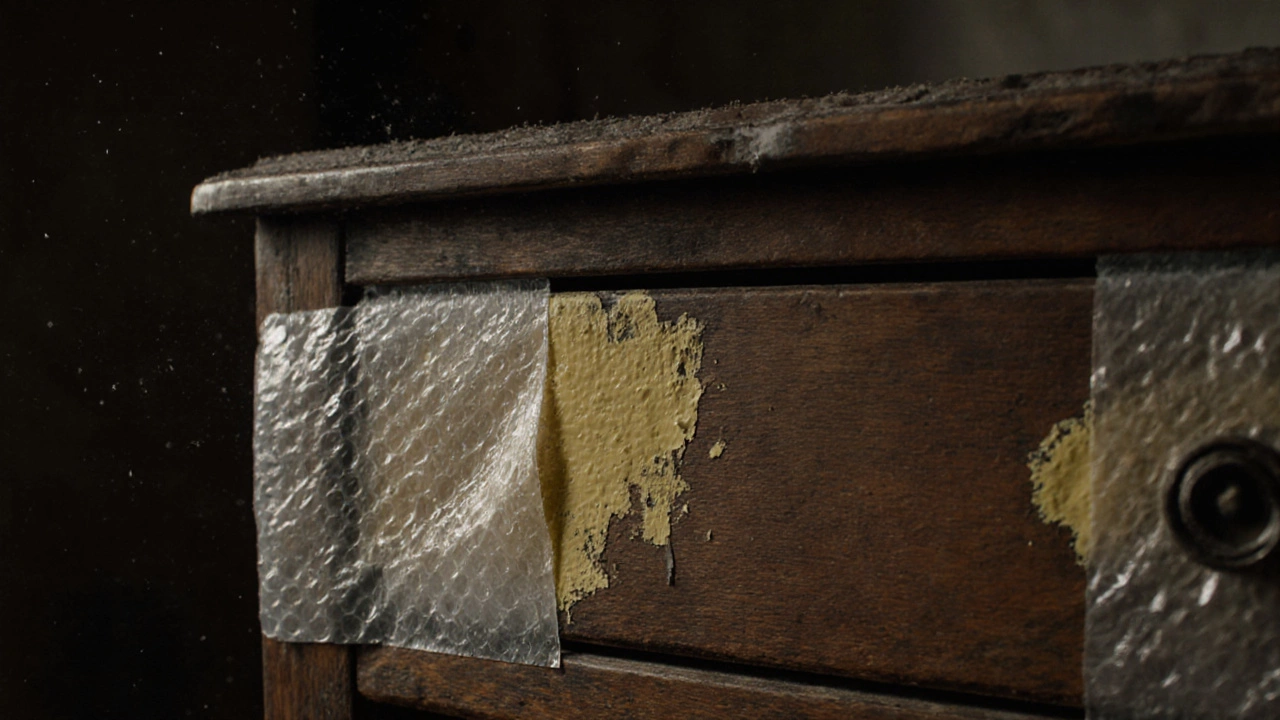Bubble Wrap Storage Risk Calculator
Find out if your stored items are at risk of damage from bubble wrap. Based on factors like storage duration, environmental conditions, and item type.
People often grab bubble wrap when they’re packing up boxes for storage-maybe for a basement, attic, or storage unit. It feels safe. It’s soft, it’s stretchy, and it cushions everything from glassware to electronics. But here’s the question most people never ask: Is bubble wrap safe for long-term storage? The answer isn’t as simple as yes or no. In fact, using it wrong can damage what you’re trying to protect.
What bubble wrap is made of-and why it matters
Bubble wrap is usually made from low-density polyethylene (LDPE), a type of plastic that’s flexible and cheap. That’s why it’s everywhere: online orders, shipping centers, moving companies. But LDPE isn’t stable over time. When exposed to heat, sunlight, or even just humidity over months or years, it starts to break down. That breakdown releases plasticizers-chemicals added to make the plastic soft. These can migrate onto surfaces, especially delicate ones like wood finishes, painted metal, or vintage fabrics.
In Birmingham, where damp winters and heated homes create constant humidity swings, this isn’t theoretical. I’ve seen antique dressers with sticky, discolored patches where bubble wrap was taped directly to the surface for six months. The damage wasn’t from scratches-it was chemical staining. And once it happens, you can’t sand it away.
The moisture trap problem
Bubble wrap isn’t breathable. That’s great if you’re wrapping a coffee mug for a cross-country move. Not so great if you’re storing a wool blanket or a leather jacket in a storage unit for two years. Trapped moisture has nowhere to go. Condensation builds up inside the wrap, especially when temperatures drop at night. That creates the perfect environment for mold, mildew, and even fabric rot.
One woman in Solihull stored her grandmother’s wedding dress in bubble wrap for five years. When she pulled it out, the silk lining was brittle, stained with brown spots, and smelled musty. She didn’t realize the wrap had turned into a sealed moisture chamber. The dress couldn’t be restored.
What about electronics and collectibles?
People wrap old TVs, vinyl records, and cameras in bubble wrap thinking they’re protecting them. But static electricity is a silent killer. Standard bubble wrap generates static as you handle it. That charge can build up and discharge into sensitive circuit boards-especially in older electronics. You might not notice right away, but over time, those tiny discharges degrade components. A 2023 study by the National Archives found that 37% of damaged vintage electronics stored with plastic wrap showed signs of electrostatic discharge damage.
And vinyl records? Bubble wrap’s texture can leave micro-scratches on the surface. Even if it looks clean, those tiny abrasions add up. They cause pops and skips that weren’t there before. For collectors, that’s a value killer.

What should you use instead?
You don’t need to avoid cushioning entirely-you just need better options.
- Acid-free tissue paper is perfect for wrapping fragile items like porcelain, mirrors, or glass. It’s inert, doesn’t degrade, and won’t stain.
- Unwaxed paper blankets (sometimes called moving blankets) are breathable and great for furniture, antiques, and fabric. They let air move while still offering padding.
- Polystyrene foam sheets (like those used in museum packing) are better than bubble wrap for electronics. They don’t generate static and offer firm, even protection.
- Archival-quality plastic boxes with ventilation holes are ideal for long-term storage. They’re rigid, moisture-resistant, and designed to last decades.
For items like leather sofas or wooden cabinets, skip plastic wrap entirely. Use a cotton sheet or a breathable storage cover. If you need to protect corners, use cardboard edge protectors. They’re cheap, recyclable, and won’t off-gas.
When bubble wrap is actually okay
It’s not all bad. Bubble wrap works fine for short-term moves-say, under six months-if used correctly.
- Never let it touch finished surfaces. Always put a layer of paper or cloth between the wrap and the item.
- Use it only for padding, not as a primary wrap. Think of it like a mattress topper-not the mattress itself.
- Store items in a climate-controlled space. Temperature swings and humidity are the real enemies.
- Remove it within a year. Don’t leave it on for longer than you’d leave a bandage on a wound.
One homeowner in Coventry stored holiday ornaments in bubble wrap for three years. She kept them in a dry, temperature-stable garage. When she opened the boxes, everything was fine-because she’d wrapped each ornament in tissue first, then loosely surrounded it with bubble wrap. The key was the buffer layer.

How to check if your stored items are at risk
If you’ve already stored things in bubble wrap, here’s how to check for damage:
- Unwrap one item in a dry, well-lit room.
- Look for sticky residue, yellowing, or discoloration on the surface.
- Smell it. A plastic or chemical odor means off-gassing is happening.
- Check for dampness or mold spots, especially in corners or seams.
- If you see any of these, stop using bubble wrap immediately and repackage with safer materials.
Don’t wait until you open everything. One bad box can ruin the whole collection.
Storage environment matters more than the wrap
No matter what you use, storage conditions make the biggest difference. Humidity above 60%? Mold will grow. Below 30%? Wood cracks. Temperatures above 80°F? Plastics break down faster. The ideal range for long-term storage is 50-60% humidity and 60-70°F.
Most home attics and basements fail this test. If you’re storing valuable items, pay for a climate-controlled unit. It’s not expensive-around £50-£80 a month in the Midlands-and it protects more than just your stuff. It protects your peace of mind.
Bottom line: Bubble wrap is a short-term fix
Bubble wrap is great for moving. It’s terrible for storing. It’s not just about protection-it’s about chemistry, moisture, and time. What feels like safety today can become damage tomorrow. If you’re planning to store something for more than a year, invest in materials designed for the long haul. Your future self will thank you.
Can bubble wrap cause mold on stored items?
Yes. Bubble wrap traps moisture and prevents airflow, creating a sealed environment where mold and mildew can grow-especially on fabrics, paper, wood, and leather. This is especially common in humid climates or uncontrolled storage spaces like basements and attics.
Is it safe to wrap electronics in bubble wrap for storage?
Not recommended. Standard bubble wrap generates static electricity, which can damage sensitive circuits over time. Even if the device works now, repeated micro-discharges can degrade internal components. Use anti-static foam or archival-grade plastic boxes instead.
How long can you safely store items in bubble wrap?
Six months is the absolute maximum. Beyond that, the risk of chemical off-gassing, static damage, and moisture buildup increases significantly. For anything you plan to store longer than a year, switch to breathable, inert materials like acid-free paper or cotton covers.
What’s the best material for storing antiques?
Acid-free tissue paper and unwaxed paper blankets are the gold standard. They’re non-reactive, breathable, and won’t stain or degrade over time. For wooden furniture, use cotton sheets and corner protectors made of cardboard. Avoid all plastics unless they’re specifically designed for archival use.
Do climate-controlled storage units really make a difference?
Yes. Humidity and temperature swings are the #1 cause of long-term storage damage. Climate-controlled units keep conditions stable-typically 50-60% humidity and 60-70°F-which prevents warping, mold, cracking, and plastic degradation. For valuable or sentimental items, it’s not a luxury-it’s essential.


Write a comment